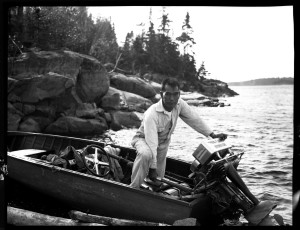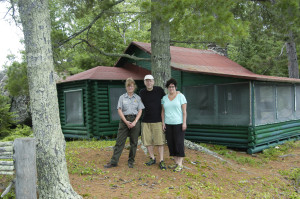Rediscovering Jun Fujita on Rainy Lake
 By Catherine Crawford and Mary Graves
By Catherine Crawford and Mary Graves
A 20-mile boat ride east from the Rainy Lake Visitor Center, through “the Brule”, and toward Kempton Channel brings the visitor to a small, rugged island scattered with pine trees and wildflowers where a modest cabin shelters against a massive rock formation.
The simply-constructed lake place of Japanese immigrant Jun Fujita and the memory of this slight, personable man who came to the secluded island soon after 1928 are part of the lore of Rainy Lake.
Reminiscences and snippets of conversations from long-time summer residents and early dwellers of the border lakes region created an incomplete and intriguing portrait of a multi-talented man. Jun Fujita ~ a respected photographer who produced images for the likes of Johnson Motors and the Chicago Evening Post ~ a gifted poet whose expressive works were published in the famed Poetry magazine ~ a racer of speed boats, which were quite an oddity on the waters of Rainy.
But the story of Jun Fujita remained incomplete for many years. Why did he choose this remote location for his cabin? Why didn’t he return to the island after 1941, though he wouldn’t sell until 1956? Was the construction of the cabin influenced by his Japanese heritage? Did he have family?
This past July, some of the pieces of the puzzle that is Fujita came together. Jun Fujita’s great nephew, Graham Lee, visited the isolated island on a personal pilgrimage. Chief of Resources Mary Graves shared that special day with Graham Lee and his wife and shares the experience with us:
“Graham first contacted me in September 2012. He had seen some of the park’s research materials about Fujita on a National Park Service website and wondered how he could visit the cabin. I was surprised to find out there was a family member who might be able to shed more light on the history of the Fujita property. The park began research on the property in 1989 and submitted a nomination to the National Register of Historic Places in 1996 after exhausting (we thought) all sources of information.
While we had no historic photos of the cabin and knew little about Jun beyond his professional life, we had sufficient hard details for the property to be accepted on the Register. Graham and I began to share information about Jun and talk about a trip to the island. Plans for a fall trip slipped away, spring came and went, and finally we agreed on July 12. Over 2 hours exploring the island with Graham and his wife Pam, Jun Fujita and the cabin he built on Rainy Lake, finally came alive.
Graham shared many stories about his great uncle and showed me photographs of the cabin Rediscovering Jun Fujita on Rainy Lake Mary Graves, Chief of Resources, with Graham and Pam Lee Courtesy of the Graham and Pam Lee Collection and other images taken by Jun. The photos not only provided missing details about the history of the cabin but revealed much more about Jun as a person.
Each photo revealed a personal touch—a bed and table crafted of birch logs, smoking pipes on a shelf, clothes on a hook, a box of cereal and plate of fish set out for breakfast, books sitting on a storage box. For Graham, I believe the experience was extremely personal. He expected the island to be much larger. He now understands more fully the portion of Jun’s life that drew him away from his work in Chicago. During those 2 hours, the spirit of Jun Fujita became anchored to the island— especially when we discovered we had unknowingly scheduled the visit on the anniversary of Jun’s death.”
Questions about Jun’s life on Rainy Lake still linger. One question that may forever remain unanswered is whether Fujita produced any of his poetry at the cabin on Rainy Lake. His poem, “Morning Woods,” makes one believe he did. Fujita is considered the first master of turning the Japanese form of poetry called Tanka into English. The poem “Morning Woods” was published in Poetry: A Magazine of Verse 1928 under the heading, “Projections.”
MORNING WOODS
A static mood, in the morning woods, Wet and clear---- In a majestic pattern, leaves are spellbound By a fawn, ears perked.

